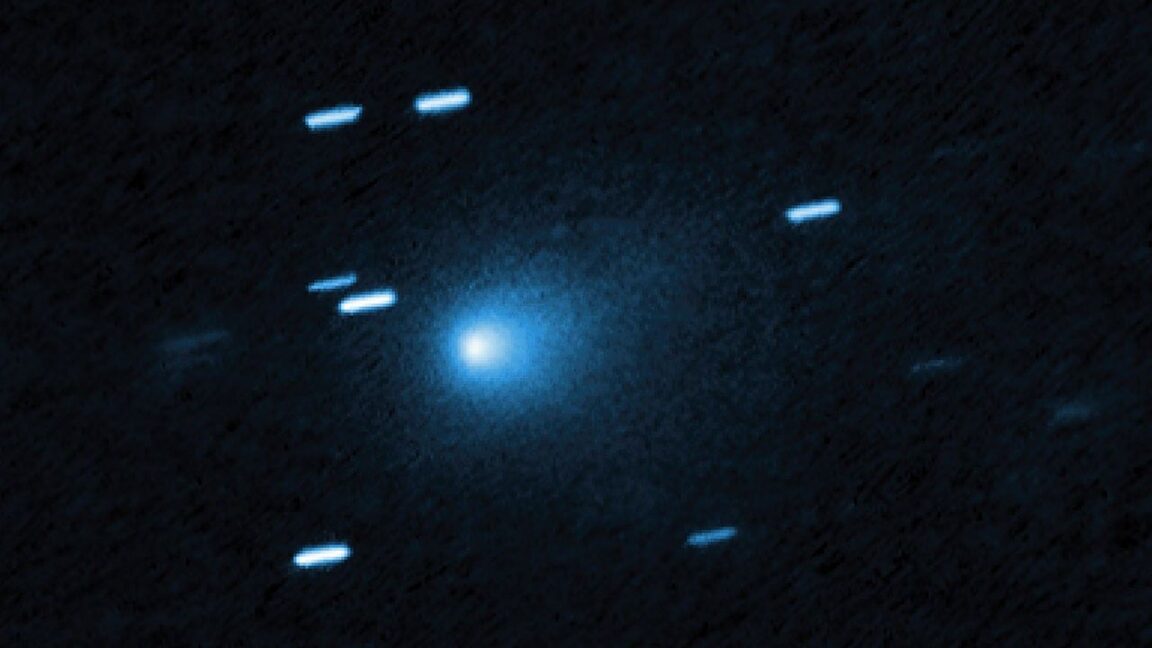Science
International Spacecraft Observe Interstellar Comet 3I/ATLAS

An international fleet of spacecraft has recently turned its attention to an interstellar comet known as 3I/ATLAS, which made its closest approach to Mars. This rogue comet, originating from beyond our Solar System, is expected to reach perihelion—its closest point to the Sun—by the end of this month. Its trajectory was first reported on July 1, 2023, marking it as the third confirmed interstellar object identified within our Solar System, following 1I/ʻOumuamua and 2I/Borisov.
As part of ongoing investigations into the mysteries of Mars, several spacecraft, including NASA‘s Perseverance rover and the Mars Reconnaissance Orbiter, shifted their focus to observe 3I/ATLAS. Due to its trajectory, the comet will not come closer than approximately 170 million miles (270 million kilometers) from Earth in December, limiting the potential for high-resolution imaging. The Sun’s glare will also obstruct direct views of the comet until next month.
The closest observations occurred recently when 3I/ATLAS passed within 20 million miles (30 million kilometers) of Mars. While the imaging capabilities of the Mars spacecraft are not as advanced as those of the James Webb Space Telescope or the Hubble Space Telescope, scientists hope to gather valuable data on the comet’s surrounding cloud of gas and dust. Initial spectroscopic observations suggest that 3I/ATLAS has a coma containing water vapor and a significant amount of carbon dioxide, extending nearly half a million miles.
The European Space Agency (ESA) has also released preliminary images of the comet taken from Mars. The most detailed insights are expected from the HiRISE camera aboard NASA’s Mars Reconnaissance Orbiter, although the release of these images is pending due to the current federal government shutdown in the United States.
3I/ATLAS is believed to have been ejected from another star system, potentially due to gravitational interactions with massive planets. It is speculated that the comet has traveled through the Milky Way for billions of years before entering the Sun’s vicinity. As it approaches perihelion, it will attain a speed of 152,000 mph (68 kilometers per second), too fast to be captured in a stable orbit around the Sun, meaning it will eventually exit our Solar System.
The scientific community recognizes the significance of interstellar objects like 3I/ATLAS. Studying them could provide insights into the formation of planetary systems. One study from the University of Oxford suggests that 3I/ATLAS originated from the “thick disk” of the Milky Way, indicating it may be over 7 billion years old.
Although some theories have suggested that 3I/ATLAS could be an artifact of alien technology, the scientific consensus remains that it is a natural object. Avi Loeb, an astrophysicist from Harvard University, has proposed redirecting NASA’s Juno spacecraft to investigate 3I/ATLAS; however, logistical challenges prevent this mission from moving forward. Juno lacks sufficient fuel for such maneuvers, and its main engine is malfunctioning.
The prospect of sending a dedicated mission to explore interstellar objects has garnered interest. Colin Snodgrass, a planetary scientist at the University of Edinburgh, is working on a project called Comet Interceptor. This mission aims to observe a long-period comet, which has remained largely unchanged by solar radiation. ESA plans to launch the mission in the late 2020s, with the hope that it could potentially encounter interstellar comets like 3I/ATLAS.
In the United States, researchers from the Southwest Research Institute are also exploring mission concepts to study interstellar bodies. Led by Alan Stern, the team has developed a plan to park a spacecraft in deep space, awaiting an appropriate target. Their concept suggests that a mission could have reached 3I/ATLAS had it been in space already.
The challenge of launching a spacecraft to intercept high-speed interstellar objects is evident. Currently, scientists can only identify these comets shortly before they approach Earth. The activation of the new Vera Rubin Observatory in Chile is expected to enhance the detection of interstellar objects, allowing for earlier warnings and potentially increasing the chances of future missions.
Despite these advancements, securing funding for such missions remains competitive and uncertain, especially after recent budget discussions regarding NASA’s science funding. ESA’s Comet Interceptor has already received backing, reflecting Europe’s ongoing commitment to comet exploration.
In summary, the study of 3I/ATLAS and other interstellar objects represents a burgeoning field of research. As telescopes improve and missions are designed, the scientific community remains hopeful about the possibility of close encounters with these cosmic wanderers, providing insights into the universe’s history and the formation of planetary systems.
-

 Science3 months ago
Science3 months agoToyoake City Proposes Daily Two-Hour Smartphone Use Limit
-

 Health4 months ago
Health4 months agoB.C. Review Reveals Urgent Need for Rare-Disease Drug Reforms
-

 Top Stories4 months ago
Top Stories4 months agoPedestrian Fatally Injured in Esquimalt Collision on August 14
-

 Technology3 months ago
Technology3 months agoDark Adventure Game “Bye Sweet Carole” Set for October Release
-

 World3 months ago
World3 months agoJimmy Lai’s Defense Challenges Charges Under National Security Law
-

 Lifestyle4 months ago
Lifestyle4 months agoVictoria’s Pop-Up Shop Shines Light on B.C.’s Wolf Cull
-

 Technology3 months ago
Technology3 months agoKonami Revives Iconic Metal Gear Solid Delta Ahead of Release
-

 Technology3 months ago
Technology3 months agoApple Expands Self-Service Repair Program to Canada
-

 Technology3 months ago
Technology3 months agoSnapmaker U1 Color 3D Printer Redefines Speed and Sustainability
-

 Technology3 months ago
Technology3 months agoAION Folding Knife: Redefining EDC Design with Premium Materials
-

 Technology4 months ago
Technology4 months agoSolve Today’s Wordle Challenge: Hints and Answer for August 19
-

 Business4 months ago
Business4 months agoGordon Murray Automotive Unveils S1 LM and Le Mans GTR at Monterey









